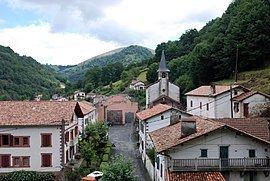Intercommunality Garazi-Baïgorri | Area 49.6 km² | |
 | ||
Canton | ||
Banca (Basque: Banka) is a French commune of the Pyrénées-Atlantiques department in the Nouvelle-Aquitaine region of south-western France in the former province of Lower Navarre.
Contents
- Map of Banca France
- Geography
- Hydrography
- Toponymy
- History
- Administration
- Inter communality
- Demography
- Economy
- Civil heritage
- Religious heritage
- Environmental heritage
- Education
- Sports
- References
Map of Banca, France
Banca is part of Pays Quint (Kintoa in Basque or Quinto Real in Spanish), an area of pasture area which belongs to Spain but is cultivated by French farmers.
The inhabitants of the commune are known as Bankars.
Geography
Banca is located in the Aldudes valley on the banks of the Nive des Aldudes some 15 km south-west of Saint-Jean-Pied-de-Port. The western and eastern borders of the commune are the national frontier between France and Spain. Access to the commune is by the D948 road from Saint-Étienne-de-Baïgorry in the north which passes through the commune and the village and continues south-west to Aldudes. There are no crossing points in the commune to Spain. The commune is mainly rugged alpine pastures.
Hydrography
The Nive des Aldudes flows from Aldudes in the south-west, gathering tributaries such as the Antchignoko Erreka, the Ruisseau d'Hayra, the Latcharrako Erreka, and the Belechiko Erreka on the northern border, and continues north-east to join the Nive south of Saint-Martin-d'Arrossa. The Ruisseau d'Hayra rises in the south of the commune and flows north gathering tributaries such as the Lehaltzarteko Erreka, the Caminarteko Erreka, and the Legarzuko Erreka to join the Nive des Aldudes near the village.
Toponymy
The commune name in Basque is Banka.
For John-Baptiste Orpustan, the origin of the name Banca can have two interpretations: one lent from the Spanish banco designating the bench on which money was exchanged (which gave the French word banque which gave the English bank) or two from bancs de pierre (stone benches).
The following table details the origins of the commune name and other names in the commune.
Sources:
History
Banca owes its origin to the revival in the 18th century of the copper mines which had operated in ancient times. Banca was known as Le Fonderie (The Foundry) until the 19th century" and, under the Ancien Régime, it was a hamlet or district under the parish of Saint-Étienne-de-Baïgorry. It was not made a commune until 1793 under the same name, then in 1874 it was renamed "Banca". The remains of a large forge, a steel foundry started in 1828 on the site of the former copper smelter, stands at the entrance of the village on the banks of the Nive des Aldudes. The most visible element is a blast furnace in good condition.
The first armed action by Iparretarrak took place in Banca on 11 December 1973.
Administration
List of Successive Mayors
(Not all data is known)
Inter-communality
The commune is part of four inter-communal structures:
Demography
In 2010 the commune had 335 inhabitants. The evolution of the number of inhabitants is known from the population censuses conducted in the commune since 1793. From the 21st century, a census of communes with fewer than 10,000 inhabitants is held every five years, unlike larger communes that have a sample survey every year.
Sources : Ldh/EHESS/Cassini until 1962, INSEE database from 1968 (population without double counting and municipal population from 2006)
Economy
The copper/silver mines and the associated smelter reached their peak in the middle of the 18th century and the forge, with its blast furnace, was in operation from 1828 to 1861.
Economic activity is now mainly agricultural. The town is part of the Appellation d'origine contrôlée (AOC) zone of Ossau-iraty.
Civil heritage
The commune has a number of buildings and structures that are registered as historical monuments:
Religious heritage
Environmental heritage
Education
The commune has a primary school.
Sports
There is a Fronton traversed by a road.
